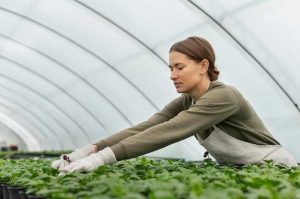

In today’s rapidly evolving world, the need for sustainable agricultural practices has become increasingly evident. As we strive to meet the growing demands of a burgeoning global population, it is imperative that we find innovative ways to enhance productivity without compromising the delicate balance of our natural ecosystems. By adopting environmentally conscious farming methods, we can achieve a harmonious coexistence between agricultural development and the preservation of our planet’s precious resources.
Efficiency lies at the heart of sustainable farming. Through the utilization of cutting-edge technologies and the implementation of strategic management practices, farmers can optimize their operations to maximize yields while minimizing waste. By carefully monitoring and managing resources such as water, energy, and fertilizers, farmers can reduce their ecological footprint and ensure the long-term viability of their agricultural endeavors.
One key aspect of sustainable farming is the promotion of biodiversity. By cultivating a diverse range of crops and incorporating natural pest control methods, farmers can reduce their reliance on chemical pesticides and herbicides. This not only protects the health of the surrounding ecosystems but also enhances the resilience of crops to diseases and pests. Additionally, the preservation of natural habitats within and around agricultural areas provides refuge for beneficial insects and wildlife, further contributing to the overall ecological balance.
Education and knowledge sharing play a crucial role in the adoption of sustainable farming practices. By empowering farmers with the necessary skills and information, we can foster a culture of environmental stewardship within the agricultural community. Through workshops, training programs, and peer-to-peer learning networks, farmers can learn from each other’s experiences and gain valuable insights into the most effective and efficient ways to implement sustainable farming practices.
In conclusion, the pursuit of sustainable farming practices is not only essential for the long-term viability of our agricultural systems but also for the preservation of our planet’s biodiversity and natural resources. By embracing innovation, efficiency, and education, we can achieve a balance between productivity and environmental conservation, ensuring a prosperous future for generations to come.
Importance of Sustainable Farming
In today’s world, the significance of adopting sustainable agricultural methods cannot be overstated. The implementation of environmentally conscious practices in the field of agriculture is crucial for the long-term well-being of our planet and the preservation of its resources. By embracing sustainable farming techniques, we can ensure the continued productivity of our farms while minimizing the negative impact on the environment.
Promoting Ecosystem Health

Sustainable farming practices prioritize the health and balance of ecosystems. By avoiding the excessive use of chemical fertilizers and pesticides, farmers can prevent soil degradation and water pollution. Instead, they focus on organic and natural methods, such as crop rotation, cover cropping, and integrated pest management. These practices not only maintain soil fertility but also support biodiversity, as they create habitats for beneficial insects and wildlife.
Ensuring Food Security
Sustainable farming plays a vital role in ensuring food security for present and future generations. By utilizing techniques that conserve soil quality and water resources, farmers can maintain the productivity of their land over the long term. Additionally, sustainable practices reduce the reliance on synthetic inputs, making farming more resilient to external factors such as climate change and market fluctuations. This resilience helps to secure a stable food supply, even in challenging times.
In conclusion, the importance of sustainable farming lies in its ability to balance productivity and environmental conservation. By adopting practices that promote ecosystem health and ensure food security, we can create a sustainable future for agriculture and safeguard the well-being of our planet.
Conservation Agriculture: A Key Approach
Conservation agriculture is a fundamental strategy that plays a crucial role in the sustainable development of farming practices. It encompasses a range of innovative techniques and methods that aim to enhance agricultural productivity while simultaneously preserving and protecting the environment. By adopting conservation agriculture, farmers can achieve long-term economic viability, soil health, and biodiversity conservation.
1. Minimal Soil Disturbance
One of the key principles of conservation agriculture is minimizing soil disturbance. This involves reducing or eliminating practices such as plowing and tilling, which can disrupt the soil structure and lead to erosion. Instead, conservation agriculture promotes the use of minimum tillage or no-till techniques, which help to maintain soil moisture, prevent erosion, and preserve soil organic matter.
2. Crop Rotation and Diversification
Crop rotation and diversification are essential components of conservation agriculture. By rotating crops, farmers can break pest and disease cycles, reduce the need for chemical inputs, and improve soil fertility. Diversifying crops also promotes biodiversity, as different plants attract a variety of beneficial insects and microorganisms, contributing to a more balanced ecosystem within the agricultural landscape.
Furthermore, conservation agriculture emphasizes the integration of cover crops, which are planted between cash crops to protect the soil from erosion, improve soil structure, and enhance nutrient cycling. Cover crops also act as a natural weed suppressant, reducing the reliance on herbicides.
3. Efficient Water Management
Water is a precious resource, and conservation agriculture recognizes the importance of efficient water management. Through practices such as precision irrigation and the use of water-saving technologies, farmers can optimize water usage, minimize water runoff, and reduce the risk of water pollution. Additionally, conservation agriculture promotes the use of organic mulches and crop residues to retain soil moisture and reduce evaporation.
In conclusion, conservation agriculture offers a holistic approach to sustainable farming practices. By implementing minimal soil disturbance, crop rotation and diversification, and efficient water management, farmers can achieve both productivity and environmental conservation. This approach not only ensures the long-term viability of agricultural systems but also contributes to the overall health and resilience of ecosystems.
Organic Farming: Promoting Environmental Health
Organic agriculture is a method of cultivation that prioritizes the well-being of the environment and promotes the health of ecosystems. By adopting organic farming practices, farmers can contribute to the preservation of natural resources, minimize pollution, and enhance biodiversity.
One of the key principles of organic farming is the avoidance of synthetic pesticides and fertilizers. Instead, organic farmers rely on natural methods to control pests and enrich the soil. This approach not only reduces the risk of chemical contamination in the environment but also helps to maintain the balance of beneficial insects and microorganisms that play a crucial role in ecosystem health.
In addition to avoiding synthetic inputs, organic farming emphasizes the use of renewable resources and the implementation of sustainable practices. This includes the use of compost and organic matter to improve soil fertility, crop rotation to prevent soil erosion and nutrient depletion, and the conservation of water through efficient irrigation techniques.
Furthermore, organic farming promotes the protection of wildlife habitats and the preservation of biodiversity. By avoiding the use of genetically modified organisms (GMOs) and focusing on natural breeding methods, organic farmers contribute to the preservation of traditional crop varieties and the conservation of genetic diversity.
Overall, organic farming is a holistic approach that recognizes the interconnectedness of the environment, agriculture, and human health. By promoting environmental health, organic farming practices not only benefit the ecosystems in which they are implemented but also contribute to the production of nutritious and safe food for consumers.
| Benefits of Organic Farming: |
|---|
| Preservation of natural resources |
| Reduction of chemical contamination |
| Enhancement of biodiversity |
| Improvement of soil fertility |
| Prevention of soil erosion |
| Conservation of water |
| Protection of wildlife habitats |
| Preservation of genetic diversity |
| Production of nutritious and safe food |
Precision Farming: Enhancing Efficiency and Sustainability

In the realm of modern agricultural practices, there exists a revolutionary approach known as precision farming. This innovative method aims to optimize agricultural processes by leveraging advanced technologies and data-driven decision-making. By harnessing the power of precision farming, farmers can significantly enhance both the efficiency and sustainability of their operations.
One of the key advantages of precision farming lies in its ability to maximize resource utilization. Through the integration of cutting-edge technologies such as GPS, remote sensing, and drones, farmers can precisely monitor and manage various aspects of their fields. This includes monitoring soil conditions, crop health, and water usage, among others. By gaining real-time insights into these factors, farmers can make informed decisions to optimize the allocation of resources, ensuring that they are used efficiently and effectively.
Furthermore, precision farming enables farmers to adopt a targeted approach to crop management. By utilizing data collected from sensors and monitoring systems, farmers can identify specific areas within their fields that require attention. This allows for the implementation of site-specific interventions, such as applying fertilizers or pesticides only where necessary, reducing the overall usage of these inputs. By minimizing the use of agrochemicals, precision farming promotes environmental sustainability by reducing the potential negative impacts on ecosystems and water resources.
Another aspect of precision farming that contributes to its sustainability is its ability to optimize yield potential. By closely monitoring crop growth and development, farmers can identify potential issues or stress factors early on. This enables them to take proactive measures to mitigate these challenges, ensuring optimal crop health and productivity. Additionally, precision farming facilitates the implementation of precision irrigation techniques, allowing for the precise application of water based on crop needs. This not only conserves water resources but also minimizes the risk of over-irrigation, which can lead to nutrient leaching and soil degradation.
In conclusion, precision farming represents a transformative approach to agriculture, enhancing both efficiency and sustainability. By leveraging advanced technologies and data-driven decision-making, farmers can optimize resource utilization, adopt targeted crop management strategies, and maximize yield potential. Through the adoption of precision farming practices, the agricultural sector can contribute to the achievement of long-term environmental conservation goals while ensuring the productivity and profitability of farming operations.
Agroforestry: Integrating Trees for Sustainable Agriculture
Agroforestry is a holistic approach to agriculture that involves the intentional integration of trees into farming systems. This practice aims to enhance productivity, biodiversity, and environmental sustainability by harnessing the numerous benefits that trees provide. By incorporating trees into agricultural landscapes, farmers can create a harmonious balance between crop production and the conservation of natural resources.
Enhancing Soil Health
One of the key advantages of agroforestry is its ability to improve soil health. Trees play a crucial role in preventing soil erosion by stabilizing the soil with their extensive root systems. The roots of trees also help to enhance soil structure, promoting better water infiltration and reducing the risk of nutrient leaching. Additionally, fallen leaves and organic matter from trees contribute to the nutrient content of the soil, enriching it and supporting the growth of crops.
Promoting Biodiversity
Agroforestry systems provide habitat for a wide range of plant and animal species, promoting biodiversity within agricultural landscapes. The presence of trees attracts beneficial insects and birds, which can help control pests and pollinate crops. The diverse vegetation in agroforestry systems also creates a more resilient ecosystem, reducing the reliance on chemical inputs and increasing the overall sustainability of the farming practices.
Furthermore, the integration of trees in agricultural areas can help preserve and restore native plant species, contributing to the conservation of genetic diversity. This is particularly important in the face of climate change, as diverse plant species can adapt better to changing environmental conditions.
- Improved soil health
- Promotion of biodiversity
- Conservation of genetic diversity
In conclusion, agroforestry offers a promising solution for achieving sustainable agriculture by integrating trees into farming systems. This practice not only enhances soil health and promotes biodiversity but also contributes to the conservation of genetic diversity. By adopting agroforestry practices, farmers can create a more resilient and environmentally friendly approach to food production.
Water Management in Sustainable Agriculture
Efficient water management is a crucial aspect of sustainable agricultural practices that promote both productivity and environmental stewardship. In this section, we will explore the various strategies and techniques employed in water management within the context of sustainable farming. By optimizing water usage, farmers can minimize waste, conserve resources, and ensure the long-term viability of their operations.
| 1. Irrigation Systems | Implementing advanced irrigation systems, such as drip irrigation or precision sprinklers, allows for targeted water delivery directly to the plant roots. This method reduces water loss through evaporation and ensures that plants receive the necessary amount of water without excess runoff. |
|---|---|
| 2. Rainwater Harvesting | Collecting and storing rainwater for agricultural use is an effective way to reduce reliance on freshwater sources. By installing rainwater harvesting systems, farmers can capture and store rainwater during periods of high precipitation, providing a sustainable and reliable water supply during drier periods. |
| 3. Soil Moisture Monitoring | Regularly monitoring soil moisture levels helps farmers determine the optimal timing and amount of irrigation required. By using sensors or manual measurements, farmers can avoid overwatering or underwatering their crops, leading to improved water efficiency and healthier plants. |
| 4. Crop Selection and Rotation | Choosing crops that are well-suited to the local climate and soil conditions can significantly reduce water requirements. Additionally, implementing crop rotation practices helps maintain soil health and moisture retention, reducing the need for excessive irrigation. |
| 5. Water Recycling and Reuse | Implementing systems for treating and reusing wastewater from agricultural activities can significantly reduce water demand. By treating and repurposing wastewater for irrigation or other non-potable uses, farmers can conserve freshwater resources and minimize pollution of natural water sources. |
By adopting these water management practices, farmers can achieve sustainable agriculture that balances productivity with environmental conservation. Efficient water usage not only benefits the farm’s bottom line but also contributes to the preservation of water resources and the overall health of ecosystems.





